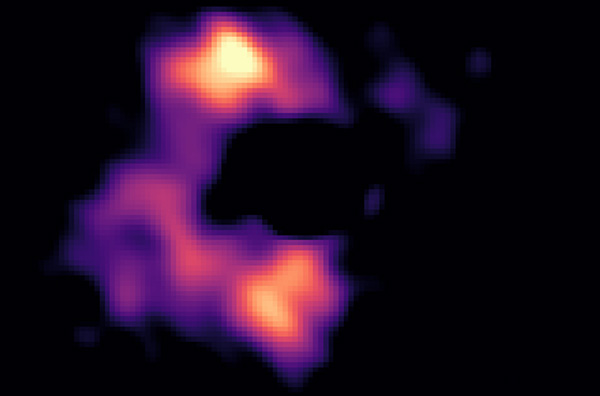The stellar wind generated in the atmosphere of the CW Leo star occurs in 'bubbles' of material
A study with the participation of ICMM shows that "bubbles" of grains of dust and molecular gas are formed in the atmosphere of this carbon star depending on their direction.

A new study led by the Spanish National Research Council (CSIC) has discovered that the stellar wind that is generated in the atmosphere of the star CW Leo, which is located 400 light years from the Solar System, occurs in a kind of "bubbles” of material, mainly dust grains and molecular gas. These “bubbles” expand until they form a circumstellar envelope. The observations made confirm the theoretical studies that indicated this stellar wind does not occur symmetrically over the entire surface.
The findings, published in the journal Nature, not only reveal new information about the best-known and most studied carbon star, but could anticipate how the Sun will behave in a few billion years.
"CW Leo is in an evolutionary stage like the one that the Sun will experience, losing material in the form of grains of dust and gas that enrich the interstellar medium and increase the chemical complexity of the Universe," explains Luis Velilla, a CSIC researcher at the Institute of Fundamental Physics (IFF-CSIC) and first signatory of the study.
“The process that we have observed is similar to the one that occurred a few years ago in the star Betelgeuse, which ejected a large bubble of material towards Earth and suffered a decrease in brightness. However, the physical mechanisms that occur in both stars do not have to be the same”, adds José Cernicharo, also a scientist at the IFF-CSIC and co-author of the study.
Although there were theoretical studies and models of the evolution of the material ejected by the star that predicted the existence of these local phenomena in the form of bubbles, to date it had not been possible to observe the phenomenon in the molecular gas in carbon-rich evolved stars with the spatial resolution provided by the new observations. “The study breaks with previous ideas, in which the stellar wind was understood as a process that occurred symmetrically over the entire surface of the star,” Velilla points out.
The work is based on observations made with the ALMA interferometer, located in Chile. Observations have also been made with the IRAM 30m radio telescope in Sierra Nevada, and the SMA in Hawaii. These observations have made it possible to verify that different gas and dust compositions can occur depending on the direction in the star because the physical and chemical conditions are different depending on the formation of these bubbles. And it contrasts with all the models of circumstellar envelopes that were used to date, which considered the formation of the wind, dust grains and molecular gas as something with spherical symmetry, that is, that it was the same regardless of the direction with respect to the star.
"Studying these processes leads us to know all the phases of how the Universe evolves and is chemically enriched from the stars to life," concludes Velilla.
The study had the participation of the Institute of Materials Science of Madrid (ICMM-CSIC), the Center for Astrobiology (CAB-CSIC-INTA), the Institut de Radioastronomie Millimétrique (France), the University of Basel (Switzerland), the Institut de Recherche en Astrophysique et Planétologie (France) and the Harvard-Smithsonian Center for Astrophysics.
L. Velilla-Prieto, J. P. Fonfríıa, M. Agúndez, A. Castro-Carrizo, M. Guélin, G. Quintana-Lacaci, I. Cherchneff, C. Joblin, M.C. McCarthy, J.A. Martín-Gago, J. Cernicharo. Atmospheric molecular blobs shape up circumstellar envelopes of AGB stars. Nature. DOI: 10.1038/s41586-023-05917-9
Instituto de Ciencia de Materiales de Madrid (ICMM)
Sor Juana Ines de la Cruz, 3
Cantoblanco, 28049
Madrid, España
Telephone: (+34) 91 334 90 00
Email: @email
Communication Office: @email

Acknowledge the Severo Ochoa Centres of Excellence program through Grant CEX2024-001445-S/ financiado por MICIU/AEI / 10.13039/501100011033

Contacto | Accesibilidad | Aviso legal | Política de Cookies | Protección de datos